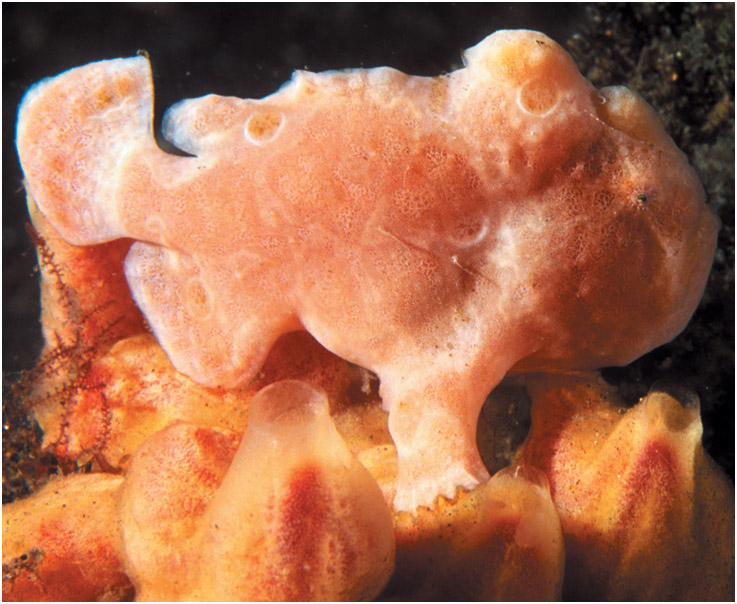

|
|
|
 |
| |
Imagine swimming along the reef, then, without warning, being swallowed whole, in less than 1/100 of a second by what you thought was a coral head. That is what would have happened if you were a small fish and the "coral head" was a frogfish.
Frogfish are small (3-4 inches on average, 8-11 for the giant frogfish)) rounded, shallow reef and sandy bottom dwellers who have been described as ugly, misshapen, fat, globular, small eyed, warty, large mouthed and, by one admiring fan, "alluring." Some observers have said, "They look like frogs."
In place of normal "fish fins," the frogfish have two stubby legs in the front, complete with hands. The front legs are used to grasp the perch, to walk on the bottom, and for defense. The two rear legs are used more for balance.
The upturned mouth can expand to 12 times its normal size, allowing the frogfish to swallow or attempt to swallow very large prey. They perch in the same spot, usually on a sponge, and with the assistance of a modified dorsal fin spine, which functions like a fishing pole, they are able to lure prey close enough to be inhaled in one gulp. |
|
| |
 |
| |
| Frogfish are in the scientific family Antennariidae and Genus Antennarius. At one time there had been as many as 165 named species of frogfish worldwide. In Frogfishes of the World, 1987, Theodore W. Pietsch reclassified the 165 into 41 species, in 12 genera. Other sources, for example, the Australian Museum, say there are only 40 plus species, in 13 genera.
To the observer, unlike other families, only a few of the frogfish are distin-guishable from one another. A good deal of the confusion results from the ability of any one frogfish to change into several colors and to cause the skin to become more or less smooth.
Frogfish show two color phases - light and dark. In the light phase, they may be light tan, yellow, light brown or rust. This phase may also include light streaks, bars or spots on the head, body and fins. During the dark phase, they may be green, dark red, dark brown, or black with dark streaks, bars or spots. Individual fish can display the entire range of colors within a few days. The changes are not instantaneous and usually occur as an adaptation to the color of new habitat.
Frogfish are found in most tropical waters at relatively shallow depths. However, the numbers vary greatly by location. In Indonesia, I photographed 17 different fish during just one week, whereas, in 15 years of Caribbean diving, I have only photographed two frogfish. |
|
| |
 |
| |
Some of the other species, which might be seen in US waters, include the Striated or Stripped (striatus) frogfish, reported to be seen under bridges on Florida's East Coast; the dwarf (pauciradiatus), reported in New England, and the giant (commersoni), reported seen in Hawaii. The Ocellated (Ocellatus) frogfish has been reported seen in the Northern Gulf of Mexico. The Sargassum (Histrio histrio) frogfish, which inhabits floating rafts of sargassum weed, could be seen wherever the rafts appear.
Frogfish are masters of camouflage. They tend to mimic the color of the habitat, and in the case of the longlure frogfish, they develop spots that look like the openings in the sponges where they perch.
Scientists think there may be a casual relationship between the species of frogfish and its habitat, but they note that the same fish will change perches to differing habitat in search of food. In both Dominica and Indonesia, however, dive guides talked about individual frogfish that had been in the same place for years. |
|
| |
 |
| |
Frogfishes fish for 50-80% of their food. The modified dorsal fin acts as a fishing pole that can be extended from a point near the top of the frogfish's head or stored along the dorsal fin. The fishing pole is longer than the frogfish's body and is made up of two parts the rod (illicium lure),which is thicker at the base and tapers to a nearly invisible width near the end and the bait (esca), located at the tip of the rod. The bait differs in appearance among species of frogfish, but the differences do not seem to be intended to catch different prey.
The frogfish will extend the bait and wiggle it above and in front of its mouth. When a curious fish is within range, the frogfish, which can be as far away as seven body lengths, begins to fish. When the prey has been lured within two-thirds of the length of the frogfish, the frogfish opens its mouth up to 12 times normal size and sucks the prey directly into the stomach. All this happens in less than 1/100 of a second. In addition to fishing, frogfish will stalk prey with a slow approach and then strike quickly.
The frogfish depends primarily on its camouflage for protection. However, if a predator comes too close or another frogfish approaches its turf, the local will inflate its body by swallowing water to appear larger. In the wild that is usually all it takes to cause the intruder to move along in search of its own spot. However, Pietsch reports that aquarium frogfish literally shred each other in territorial disputes. |
|
| |
 |
| |
Frogfish tend to be solitary except during reproduction periods. As with many other fish, the frogfish reproduces when the female releases eggs and the male releases sperm in the water column. The egg mass of some species is estimated to contain as many as 288,000 individual eggs. The sperm is carried into the egg mass by water. The egg mass, which may be 45 inches long, begins to disintegrate within 2-3 days. The eggs will begin to hatch in as little as two days in 80-degree water and take as long as four days in 70 degree water. Within two months juvenile frogfish are recognizable.
Don't Miss It!
This charming, although warty and bulbous, sea dweller should be a "must see" for every diver. To find them check the REEF database when diving in the Caribbean. Also, inquire with dive operators and dive guides at your destinations for the location of frogfish. If they have been sighted, there is a good possibility that they are still in the same spot. However, like other fishermen, if the angling is not good, they will have moved on. |
|
| |
 |
|
| |
|